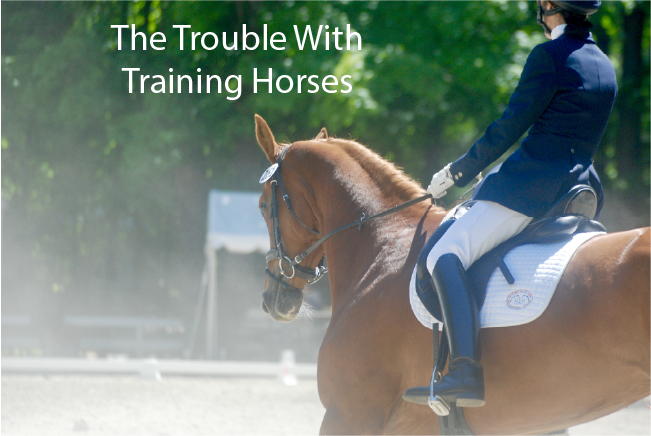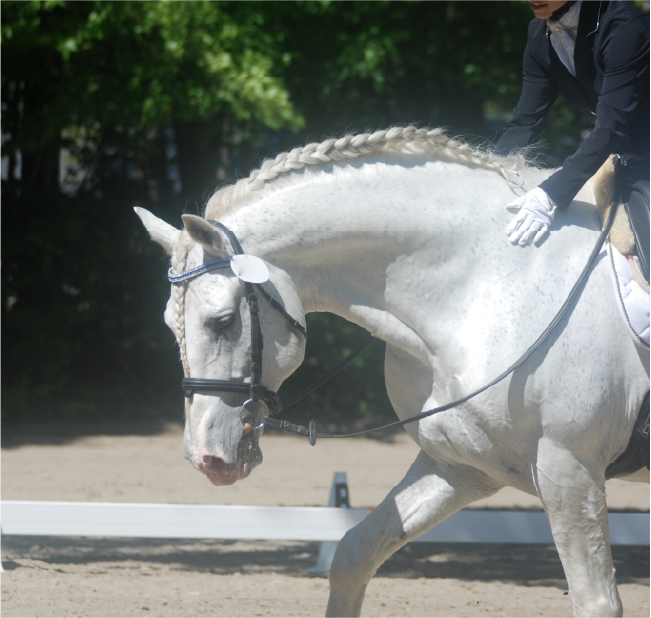The Trouble With Training Horses
By Tina Hammond

How the horse world turns is often a conundrum. The balance between art and sport in equestrian endeavors is always a tough one to address. But then factor in the 1500 pounds of horseflesh and his willingness to participate in the process and you can see that it is easy for ambition to exact control to get in the way of smart or sane training practices.
I’ve been a groom at major equestrian events and also been a competitor. The standards of the F.E.I. and their enforcement have to be front and center if the riding disciplines are to continue in huge sporting events such as the Olympics. I have seen many things happen that should never happen to horses either at home, or at events. Despite the presence of technical delegates and other competitors and grooms or staff or boarders at the barn, there is a certain nonchalance that we are all guilty of when it comes to what is happening somewhere else. Things that are not likely reported for fear of retribution. I am guilty of turning a blind eye just as many of my fellow riders are.
There is and will always be abuse of horses in the care and control of humankind. This is of course very sad. The horse truly is a noble animal and there should not be any level of pain and suffering inflicted on any creature, but that is not the way the world turns.
Most certainly every riding discipline has its faults when it comes to training methods. Indeed many disciplines are not included under the F.E.I. umbrella just because they are not worthy of inclusion due to the distress they cause to horses that is apparent. From soaring Saddlebreds to horse racing horrors – there are many areas of horse training and care that can and need to be improved.
But what goes on behind the barn or behind closed barn doors will always be hard to monitor. Oh – if horses could talk. But they can’t, and only our vigilance can be their protection.
That being said there are many instances when a strong presence or action is necessary working around horses that can come off as being aggressive. They are big animals and they don’t always comply or act in a safe manner. They can easily become undone. Circumstances that cannot always be avoided can cause significant injury to both horse and human.
The balance between art and sport in horse riding, particularly in my arena which is dressage, has long been held as the reasoning between horses being pushed to extreme lengths in the sport toward rewards from judges that favor a certain protocol or ‘look’. This is an endless conversation that has gone on for decades and will likely continue.
Just because a horse is ridden for art or exhibition does not mean it will necessarily endure any less duress than one that competes for most of its life at events.
Global politics and Salem style hunts of individuals that have been shown by modern media methods doing bad things to horses they are training will always arise.
There are many of us that have utilized a whip to scold a horse, or to try and motivate it forward into a confined space such a horse box. But there is a balance in this behavior that must be moderate and within context of an overall situation. A rearing horse for example with rider at risk may be chased forward though better the rider take an inside rein and take the horse’s head to one side to bring him to the ground. The bigger picture is why isn’t the horse moving forward?
The desire to do right by the horse can easily become a grey line that we might cross when we become fearful or angry. Patience is a virtue and not all possess it. Not all are interested in acquiring or developing it either. That is sad indeed.
Then there is the question of knowledge. How do we as trainers learn how best to train a particular horse? Mentorship can influence our methods, Results or lack of good ones certainly will.
At the end of the day each of us can only do our best to be kind. Not just with how we work with horses but with each other. There are many people currently trying to stay, ‘under the radar’ for fear of a video or damming statement surfacing about their past horse training moments.

The public forum can indeed be a hanging ground. A courtyard for the execution of one individual’s career. Holier than now attitudes persist. That is humankind. I cannot count how many times have I been participating in a clinic and seen the clinician put on hold a move or training idea because they realize the horse and/or rider cannot accomplish the desired result in the timeframe or format of the clinic, or perhaps ever.
The rider, especially if another trainer, will always be quick to complain to other trainers that they felt humiliated or that the clinician doesn’t know what they are doing. And yet I can see the reverse is true. The clinician has made the right decision.
There are good decisions and bad ones, as horse people and indeed as humans we have all made them. We may regret them. We may not. We may repeat them. We may not.
We are at the end of the day, human after all.



